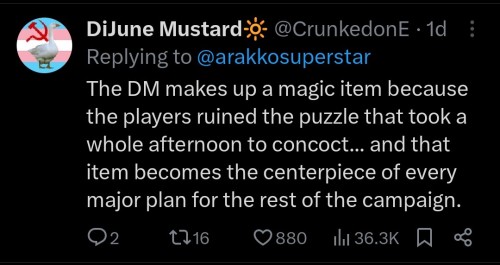Badweatherbartender

More Posts from Badweatherbartender and Others
openin’ the door to the microwave one second early because you don’t need all the hootin’ and hollerin’










I just saw a screencap of a tweet that said, “married couple looking for experience dom to tell them what to make for dinner each night” and honestly, yeah. Same.
You cannot look me in my eyeballs and tell me "The series really picks up in the fifth book and then they're all bangers, you should try them." I AM NOT READING FOUR SHITTY BOOKS FIRST. WHO HAS THE TIME.
ADHD is such nonsense sometimes. I was worried my PMDD had escalated and was continuing into my cycle and that I’d never know the warmth of sunshine on my skin or the fresh taste of strawberries.
And then I decluttered the bedroom and removed something I’d been meaning to tackle for weeks and ah, I see. I am not in actual fact on the brink of a nervous breakdown, I was just visually overstimulated and my ADHD was doing the nervous system equivalent of a chihuahua shaking itself to death out of sheer nervous existence. As though I don’t have actual Horrors to be overwhelmed by but no, the chair in the corner that had become a dumping ground for all my stuff was my mental limit.

putting this under the cut so you all have the same emotional experience i just did


OKAY THIS ARTICLE IS SO COOL
I'm going to try to explain this in a comprehensible way, because honestly it's wild to wrap your head around even for me, who has a degree in chemistry. But bear with me.
Okay, so. Solids, right? They are rigid enough to hold their shape, but aside from that they are quite variable. Some solids are hard, others are soft, some are brittle or rubbery or malleable. So what determines these qualities? And what creates the rigid structure that makes a solid a solid? Most people would tell you that it depends on the atoms that make up the solid, and the bonds between those atoms. Rubber is flexible because of the polymers it's made of, steel is strong because of the metallic bonds between its atoms. And this applies to all solids. Or so everybody thought.
A paper published in the journal Nature has discovered that biological materials such as wood, fungi, cotton, hair, and anything else that can respond to the humidity in the environment may be composed of a new class of matter dubbed "hydration solids". That's because the rigidity and solidness of the materials doesn't actually come from the atoms and bonds, but from the water molecules hanging out in between.
So basically, try to imagine a hydration solid as a bunch of balloons taped together to form a giant cube, with the actual balloon part representing the atoms and bonds of the material, and the air filling the balloons as the water in the pores of the solid. What makes this "solid" cube shaped? It's not because of the rubber at all, but the air inside. If you took out all the air from inside the balloons, the structure wouldn't be able to hold its shape.
Ozger Sahin, one of the paper's authors, said
"When we take a walk in the woods, we think of the trees and plants around us as typical solids. This research shows that we should really think of those trees and plants as towers of water holding sugars and proteins in place. It's really water's world."
And the great thing about this discovery (and one of the reasons to support its validity) is that thinking about hydration solids this way makes the math so so so much easier. Before this, if you wanted to calculate how water interacts with organic matter, you would need advanced computer simulations. Now, there are simple equations that you can do in your head. Being able to calculate a material's properties using basic physics principles is a really big deal, because so far we have only been able to do that with gasses (PV=nRT anyone?). Expanding that to a group that encompasses 50-90% of the biological world around us is huge.
need to know for a dnd game, how do I say “stop getting brainwashed, you fucking prick” in any slavic language?
do Ents reproduce by sexual intercourse or by pollination
i love y'all but everyone saying "okami 2" like my boy here suffered for nothing

-
 reversewerewolf reblogged this · 1 month ago
reversewerewolf reblogged this · 1 month ago -
 badmotherhuberd liked this · 1 month ago
badmotherhuberd liked this · 1 month ago -
 juststarsandthemoon reblogged this · 1 month ago
juststarsandthemoon reblogged this · 1 month ago -
 juststarsandthemoon liked this · 1 month ago
juststarsandthemoon liked this · 1 month ago -
 waterbenderftw liked this · 1 month ago
waterbenderftw liked this · 1 month ago -
 oomphaloskepsis reblogged this · 1 month ago
oomphaloskepsis reblogged this · 1 month ago -
 klavat reblogged this · 1 month ago
klavat reblogged this · 1 month ago -
 klavat liked this · 1 month ago
klavat liked this · 1 month ago -
 pinkcowqueen liked this · 1 month ago
pinkcowqueen liked this · 1 month ago -
 seratheinsane liked this · 1 month ago
seratheinsane liked this · 1 month ago -
 aliceandover reblogged this · 1 month ago
aliceandover reblogged this · 1 month ago -
 addieinfanworld liked this · 1 month ago
addieinfanworld liked this · 1 month ago -
 realhuacheng liked this · 1 month ago
realhuacheng liked this · 1 month ago -
 timewornbookworm reblogged this · 1 month ago
timewornbookworm reblogged this · 1 month ago -
 vinniehorrible reblogged this · 1 month ago
vinniehorrible reblogged this · 1 month ago -
 12pandas liked this · 1 month ago
12pandas liked this · 1 month ago -
 some-doggo liked this · 1 month ago
some-doggo liked this · 1 month ago -
 femininature liked this · 1 month ago
femininature liked this · 1 month ago -
 childlessmotherseal liked this · 1 month ago
childlessmotherseal liked this · 1 month ago -
 thephilosophyofblank liked this · 1 month ago
thephilosophyofblank liked this · 1 month ago -
 reader-writer-combo reblogged this · 1 month ago
reader-writer-combo reblogged this · 1 month ago -
 baddaydiary liked this · 1 month ago
baddaydiary liked this · 1 month ago -
 memoriesofgelmorra liked this · 1 month ago
memoriesofgelmorra liked this · 1 month ago -
 rarepairnation liked this · 1 month ago
rarepairnation liked this · 1 month ago -
 ofamarigold reblogged this · 1 month ago
ofamarigold reblogged this · 1 month ago -
 ofamarigold liked this · 1 month ago
ofamarigold liked this · 1 month ago -
 kingofthearsinal liked this · 1 month ago
kingofthearsinal liked this · 1 month ago -
 spatef reblogged this · 1 month ago
spatef reblogged this · 1 month ago -
 spatef liked this · 1 month ago
spatef liked this · 1 month ago -
 wafflewhales liked this · 1 month ago
wafflewhales liked this · 1 month ago -
 mattoflamancha liked this · 1 month ago
mattoflamancha liked this · 1 month ago -
 backroadtraveler reblogged this · 1 month ago
backroadtraveler reblogged this · 1 month ago -
 backroadtraveler liked this · 1 month ago
backroadtraveler liked this · 1 month ago -
 paloriee liked this · 1 month ago
paloriee liked this · 1 month ago -
 silverrocketship reblogged this · 1 month ago
silverrocketship reblogged this · 1 month ago -
 itsagrotslife liked this · 1 month ago
itsagrotslife liked this · 1 month ago -
 m-a-crow liked this · 1 month ago
m-a-crow liked this · 1 month ago -
 endlesslyendlessly liked this · 1 month ago
endlesslyendlessly liked this · 1 month ago -
 loraletuce liked this · 1 month ago
loraletuce liked this · 1 month ago -
 ineptone reblogged this · 1 month ago
ineptone reblogged this · 1 month ago -
 bootlegfriend reblogged this · 1 month ago
bootlegfriend reblogged this · 1 month ago -
 bootlegfriend liked this · 1 month ago
bootlegfriend liked this · 1 month ago -
 chacha-rouge liked this · 1 month ago
chacha-rouge liked this · 1 month ago -
 mo0nrune liked this · 1 month ago
mo0nrune liked this · 1 month ago -
 mikalovesmonsters liked this · 1 month ago
mikalovesmonsters liked this · 1 month ago -
 bloodnbubbles liked this · 1 month ago
bloodnbubbles liked this · 1 month ago -
 pure-chaos-05 reblogged this · 1 month ago
pure-chaos-05 reblogged this · 1 month ago -
 pure-chaos-05 liked this · 1 month ago
pure-chaos-05 liked this · 1 month ago -
 ameliejoyart liked this · 1 month ago
ameliejoyart liked this · 1 month ago
